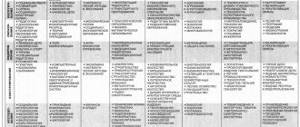"Let's get acquainted" Parent meeting in 5th grade
Parent meeting
" Let's get acquainted!"
Goals:
- introduction of parents and new class teacher;
2) creating an emotional mood for joint work, an atmosphere of mutual trust;
3) drawing up a plan (topics) for parent meetings for the year in accordance with the identified problems.
Participants:
parents, class teacher of 5th grade students.
Preparation:
- 1-2 weeks in advance, the class teacher invites parents to a parent-teacher meeting with invitation letters.
- Cl. The teacher conducts a mini-questionnaire among the class students “Communication between children and parents in person”
Design, equipment and inventory.
- The board in the office is decorated with student drawings (without signatures).
- There are tables against the wall on which there are special pieces of paper for business cards, as well as markers, felt-tip pens and pins.
- Chairs for meeting participants are placed in a circle in the center of the office.
- Mini-profiles of 5th grade children.
Progress of the meeting.
- Quiet music is playing in the office. Parents go into the office and sit on chairs.
- Opening speech by the class teacher.
Good afternoon, dear parents! I thank you for coming to our meeting. Today it will be unusual. We will conduct it in the form of a joint conversation, a frank conversation about the problems of education. I would like everyone to speak out today. First, let's get acquainted. Now you need to go to the tables near the wall and make yourself a business card. Let this business card reflect what kind of address you would like to hear during the day, and the information that you consider necessary to indicate (report) about yourself. Dare, fantasize!
- Parents working on business cards. After making a business card and attaching it to their clothes, the parents return to the circle.
- Classroom teacher:
We continue to work. Let's now introduce ourselves according to our business cards, and also tell us a little about ourselves, about the problems that concern us. Let's immediately agree that today we will not evaluate anyone, we will not criticize anyone, our task is to create an atmosphere of mutual favor and trust.
The class teacher also participates in the conversation.
Summing up, the class teacher explains that the presence of problems is inevitable, especially when people think about life and the people who live next to them. In addition, seeing a problem means taking the first step towards solving it. The second step will be improving life, in this case, family. It's always easier to solve problems together, so let's continue to get to know each other, and for this we'll play.
- The class teacher plays the following game with parents:
Now we will have the opportunity to continue our acquaintance. Let's do it this way: the person standing in the center of the circle (for starters, it will be me) offers to change places (change seats) to all those who have some common characteristic. He calls this sign. For example, I will say: “Change seats, those who have sisters,” and everyone who has a sister should change places. In this case, the one who stands in the center of the circle must try to have time to take one of the free places, and the one who remains in the center of the circle without a place continues the game. Let's use this situation to learn more about each other.
- Group work of parents.
Classroom teacher:
And now I invite you to familiarize yourself with the mini-questionnaire filled out by your children. Consider the mini-questionnaires, compare them with each other, try to guess which mini-questionnaire belongs to your child.
Discuss your observations.
Check your guesses.
The class teacher gives parents the handout “Children learn to live from life.”
Memo to parents “Children learn to live from life”
If:
- the child is constantly criticized, he learns... (HATE)
- the child lives in hostility, he learns... (BE AGGRESSIVE)
- the child grows up in reproaches, he learns... (LIVE WITH A FEELING OF GUILT)
- the child grows up in tolerance, he learns... (UNDERSTAND OTHERS)
- the child is praised, he learns... (BE GRATEFUL)
- a child grows up in honesty, he learns... (BE FAIR)
- the child grows up in safety, he learns... (BELIEVE IN PEOPLE)
- the child is supported, he learns... (VALUE YOURSELF)
- the child is ridiculed, he learns... (BE CLOSED)
10) the child lives in understanding and friendliness, he learns...
(FINDING LOVE IN THIS WORLD)
- Parent survey.
For parents to work, tables and chairs are rearranged in the office and work stations are created.
The family is the first stable group in the life of a little person. In the process of personality formation, the family plays a dominant role. It is in the family, even before school, that the main character traits of the child and his habits are formed. And what kind of child will be - prosperous or not - depends on what the relationships in the family are between its members. Family life is diverse, there are no families without problems, without difficulties.
Our task is to understand which aspects of upbringing contribute to the development of children, their adaptation at school and in society, and which factors are inhibitory and deviate development from the norm...
The class teacher asks parents to fill out a questionnaire that will help him learn better about the relationship between children and parents.
Parents answer the questionnaire. Each parent is given an answer sheet.
Questionnaire for parents.
- What kind words do you use when communicating with your child?
- What measures of influence on the child are used in the family?
- Your child's favorite toys.
- What do they mean to him?
- How is a child rewarded in the family and for what?
- What are your child’s hobbies and how do you feel about his hobbies?
- What positive character traits do you see in your child?
- What negative character traits should you try to correct?
- What do you want your child to look like after finishing 5th grade?
Diagram of a typical student's school day
Question for parents (for making a diagram)
How long does it take your child to:
- to bed
- for school
- on friends
- to work around the house
- to communicate with family
- for loneliness
- for everything else?
What would you like to change about this diagram?
- Drawing up a plan for parent meetings for the year.
Now we face the last stage of work. I suggest that you once again discuss in groups the problems related to raising children that have already been raised today, and based on this, draw up a rough plan for parent-teacher meetings for the year. You are given 5-10 minutes to work. Representatives of the groups will then speak and justify their options.
- Discussion and approval of the topics for parent meetings for the year.
- Summarizing.
Classroom teacher:
Our meeting has come to an end. I hope you enjoy working together. There is a long way ahead, but together we can solve many problems. The decision of our meeting will be the adoption of the theme of the parent meetings that will be held this school year.
Mini-questionnaire
"Communication between children and parents in person"
Dear boys and girls!
Look carefully at the facial facial poses depicted and answer the following questions:
1 2 3 4
- Which face do your parents use most often to communicate with you?
- Which person do you most often communicate with your parents?
- What do you think your parents' face should look like when communicating with you?
Mini-questionnaire
"Communication between children and parents in person"
Dear boys and girls!
Look carefully at the facial facial poses depicted and answer the following questions:
1 2 3 4
- Which face do your parents use most often to communicate with you?
- Which person do you most often communicate with your parents?
- What do you think your parents' face should look like when communicating with you?

